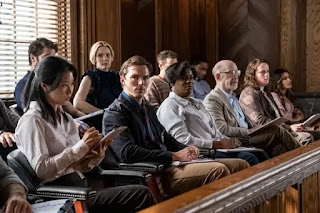Gomes's classically postmodern masterpiece is two films at once: luxuriant non-fiction travelogue and heavily narrated tale of missed connection. The former film critic turned leading light of serious art cinema allows his many contradictions to remain unresolved, creating a new, unashamedly anachronistic, vibe-filled form of period film that relies heavily on the two-part story's overlapping Asian settings. In turns an heir to Apichatpong, Oliveira, and always Godardian in its approach, Gomes's thick, pregnant black-and-white images gesture back equally to an outmoded era of Hollywood exoticism. That I would choose Grand Tour as the year's best was never in doubt.
2. By the Stream (Hong Sang-soo, South Korea)
Even if Hong's breathtaking recent productivity--sixteen features since 2015--is best understood as a single monumental text, his ever-renewable capacity for variation has continued to yield one major new work after another. The autumnal By the Stream, his second feature of 2024 after A Traveler's Needs, may be the most vertical and expansive of his recent films, tracing a theatrical artwork from inspiration and authorship through rehearsal, production and reception. Here, Hong gives us as much drama and romance as he has in some time, while his real-life lover-collaborator Kim Min-hee claims creative agency as a fictional art instructor.
3. Misericordia (Alain Guiraudie, France/Spain/Portugal)
Beautifully capturing Southern France's cool late autumn through the damp, overgrown forests and cobblestone village settings to which the film's enigmatic lead returns repeatedly, Misericordia is engrossing cat-and-mouse business built on quotidian repetition. Balancing these seemingly oppositional qualities is Guiraudie's sense of the absurd and his preference for actions that resist easy psychological interpretation. What emerges instead is a film filled with gender fluid, often unexpressed desires, and the accompanying thanatos. When the film's priest springs up in the midst of the concluding chase, the Stranger at the Lake director reaffirms his leading position among French cinema provocateurs.
4. The Shrouds (David Cronenberg, Canada/France)
Could The Shrouds be the ultimate Cronenberg film? With Vincent Cassel unambiguously adopting the position of the director's surrogate, bereft at the loss of his longtime partner, the Canadian master enters his deceased wife's grave. Underground, with Cassel spying her decaying corpse as the corporeal is transposed into digital code (as some more perceptive critics have noted), Cronenberg bears witness to the greatest horror to befall the body--along with her disfiguring cancer that populates Cassel's virtual memories and dreamlife. Pure in its classical decoupage, the filmmaker's latest is darkly humorous and very palpably erotic, despite its funereal subject.
5. Abiding Nowhere (Tsai Ming-liang, United States/Taiwan)
Tsai's tenth installment in his experimental "Walker" series masterfully proposes an empathetic, almost sculptural form of spectatorship where the viewer feels the heaviness of Lee Kang-sheng's limbs as he glacially crosses the film's Washington, DC landscape. In his latest gallery-adjacent effort, Tsai invites new comparison to his larger fictional corpus as Anong Houngheuangsy reprises his Days role as an alternating presence to the monumentally slow Lee. The Buddhist Abiding Nowhere heightens and focuses our perception of stasis and movement like no other film this year, encouraging its more active spectators to consider the medium's grounding in discrete still images.
6. Caught by the Tides (Jia Zhang-ke, China)
Stitched together with digital remainders captured during his Unknown Pleasures and Still Life productions (and newly shot 2020s material), Caught by the Tides is Jia's COVID-period project, both in the subject of the film's third part and in its editing room form of production. In returning to these previous texts, Jia has created a survey of China's most consequential twenty-first century events, from the euphoria of the Beijing Olympics to the displacement of the Three Gorges Dam and the Wuhan virus. A melancholic platform for Zhao Tao's spectacular beauty, Caught by the Tides measures China's unseen advancement to global superpower.
7. Juror #2 (Clint Eastwood, United States)
A welcome return to the nimble classicism of 1990s-era Eastwood, this supremely well-paced and involving courtroom drama revives Eastwood's decades-long interest in questions of justice, framing it within a system ruled by personal motivations and prejudices. Culpability, both legal and moral, is a central concern here as we motor toward a final silent showdown that expertly replaces dialogue with shot/reverse-shot strategies. Juror #2 contains many markers of prime Eastwood, from its extra-legal investigations to its spirit of professionalism that inhabits its many un-showy performances. Ultimately, Hollywood mercilessly ignored one of the best films it produced this year.
8. Youth (Homecoming) (Wang Bing, France/Luxembourg/ Netherlands)
China's greatest living documentarian concludes his massive, nine-hour-plus "Youth trilogy" with this compulsively watchable and distinctive final installment. Over their new years' holidays, Wang travels with his subjects in packed railcars and over perilous, if scenic mountain roads, which lead to their economically disadvantaged small towns. After sharing a family meal, celebrating a wedding or simply passing the time, Wang's young factory workers will again return to the sweatshops, grim workers' housing and to the chaotic fraternization that dominated the first two films. The essential, observational 'Youth' films reveal the foundations of our global consumer life like no other films this year.
9. All We Imagine as Light (Payal Kapadia, France/India/ Netherlands/Luxembourg/Italy)
For her richly nocturnal Night of Knowing Nothing follow-up, Kapadia provides an expansive portrait of what it is to live in Mumbai with its transplanted rural masses, and its flooding monsoonal rains. City and countryside, Hindu and Muslim, and arranged marriage and romance provide the structuring conflicts in this bifurcated story of two women as they travel south from the global megacity and cinema capital. This assured instance of international art cinema, with its tangible eroticism and its twenty-first century admixture of fiction and non-fiction, may be familiar, but it still stands as conspicuous counter-cinema to India's dominant commercial modes.
10. Trap (M. Night Shyamalan, United States/Canada)
Among the more overtly personal films of Shyamalan's critically marginalized career, Trap relies on director's daughter Saleka's very credible turn as a popstar, before the film's uber-Hitchcockian focalization shifts to her from Josh Harnett's suspected serial killer. Up to that point, the horror-thriller auteur has given us his own B-film take on Bresson's A Man Escape--not to mention a literal Parent Trap--with Harnett's scheming, paternal psycho plotting his slip from the tightening dragnet. Graced with thematically potent frontal close-ups and fluid overhead takes, Shyamalan's visual pyrotechnics invigorate this new-school collage of 21st-century tech, social media and fan culture.










No comments:
Post a Comment